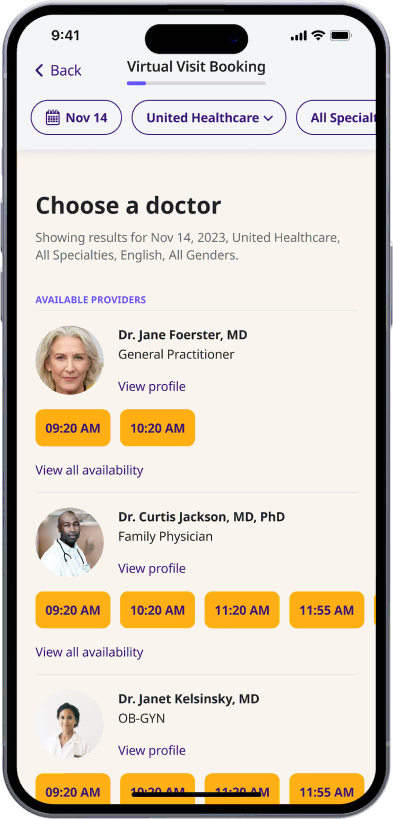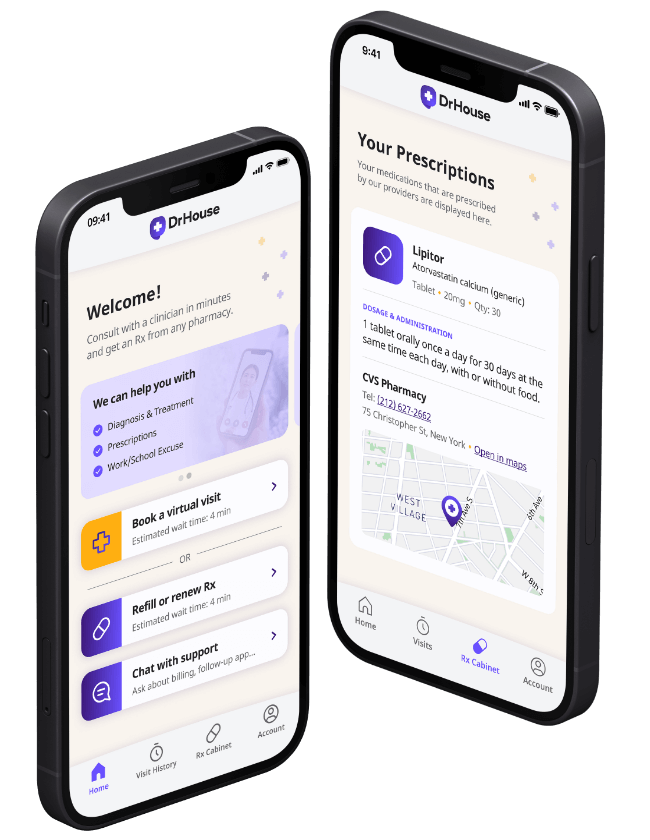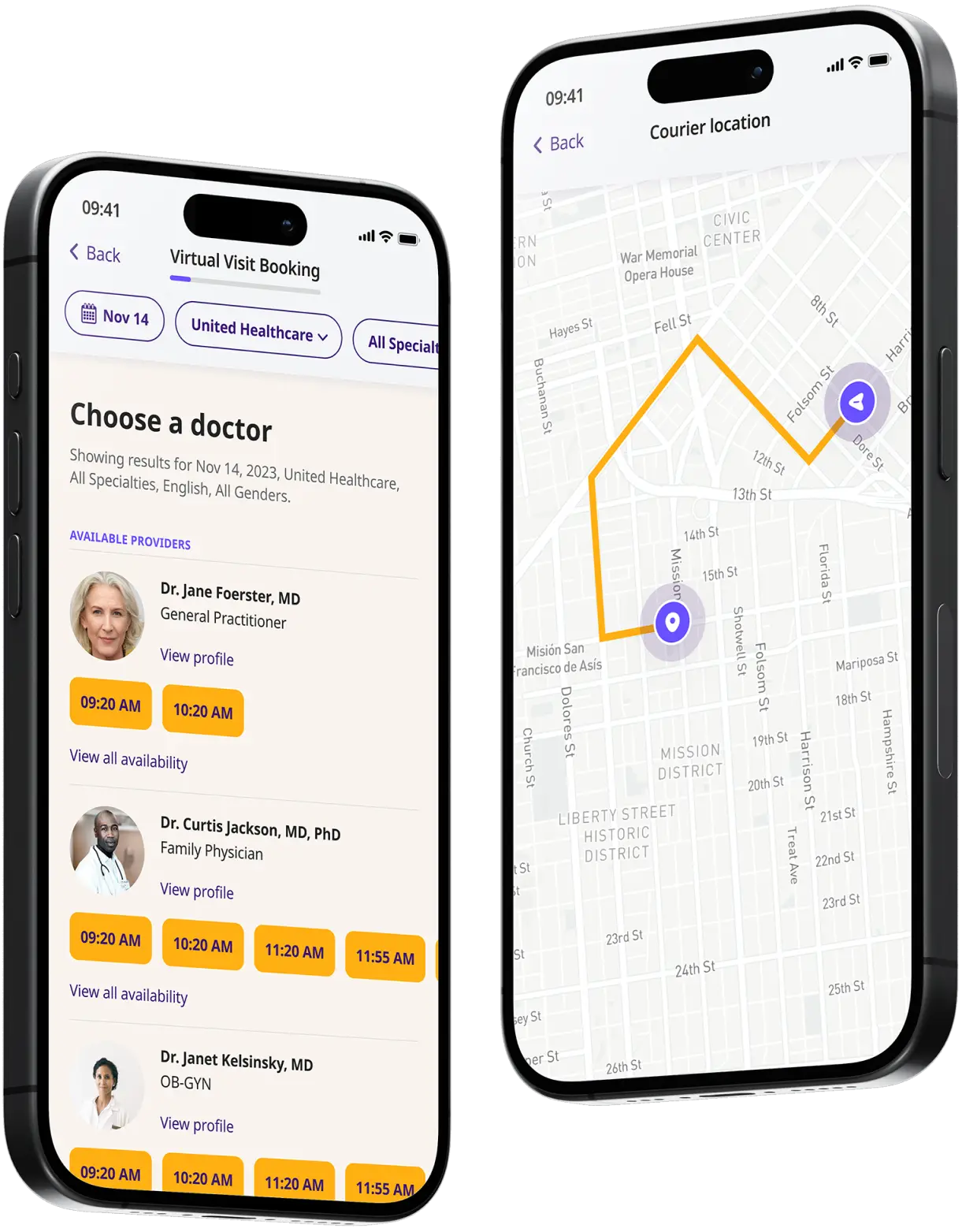Get Migraine Treatment Online
Effective, 24/7 virtual migraine treatment with personalized care & fast prescriptions from DrHouse online doctors.


Available in 50 states. Insurance accepted.
Fast
virtual visits
24/7 care
assistants
Prescriptions
as needed

24/7 Personal Care
Consult with a physician in 15 minutes, refill an Rx or chat with our care assistants.

Affordable & Convenient
See your cost upfront and get treatment for hundreds of different conditions.

Insurance Accepted
We accept most major insurance plans, making healthcare easy and affordable.
See If Delivery Is Available Near You
Delivery Not Available
Enter your ZIP code to check if prescription delivery is available in your area and how soon your meds could arrive.
How to get started
Choose your doctor, start a virtual visit, and have your prescriptions sent to your preferred pharmacy for pickup — all in just a few easy steps.
Choose a doctor
Choose a physician by availability, specialty, ratings, and more.

Start your video visit
Connect with a doctor in minutes on a secure video call.

Get your prescription
Pick up your meds or have them delivered in as little as an hour.

Available in 50 states. Insurance accepted.
One-Time
Physician Visit
One-time visit with a physician for diagnosis, treatment, Rx, labs, referrals, and doctor’s notes.
Accepted Insurances
See why people turn to DrHouse...
As seen in

Effective online migraine treatment & relief with DrHouse
Migraines can disrupt daily life, making even simple tasks feel impossible. DrHouse is here to bridge the gap between effective migraine relief and accessible healthcare.
With our 24/7 telehealth services, you can connect with experienced, board-certified physicians who are dedicated to understanding your unique needs and providing tailored treatment.
Whether it’s managing acute symptoms or creating a long-term prevention plan, DrHouse ensures you receive timely, comprehensive, and compassionate care. Our telehealth platform is designed for ease, empowering you to take control of your health from the comfort of your home.
About migraines
Migraines are a specific type of headache known for their intensity and recurrent nature. Unlike common headaches, migraines are often accompanied by symptoms that affect daily functioning.
Studies have shown that migraines affect over a billion people worldwide, with women three times more likely to suffer from them than men. Migraines generally peak between the ages of 15 and 55, although they can occur at any stage of life.
Overview and types of migraines
Migraines come in different forms, each with its own set of characteristics:
- Migraines with aura: These are preceded by sensory disturbances that can include visual flashes, blind spots, or tingling sensations. Auras typically occur 10 to 30 minutes before the migraine pain begins.
- Migraines without aura: The most common type, marked by moderate to severe pain on one side of the head, often with nausea and sensitivity to light and sound.
- Chronic migraines: Defined by having headaches on 15 or more days per month, with at least eight days of having migraine characteristics.
- Hemiplegic migraines: Rare and severe, these migraines can cause temporary weakness on one side of the body, mimicking stroke-like symptoms.
Symptoms of migraines
Migraines are more than just head pain. The symptoms can be varied and affect different parts of your body:
- Pain: Typically throbbing or pulsating, often localized to one side of the head.
- Nausea and vomiting: These gastrointestinal issues are common during a migraine attack.
- Sensitivity to light and sound: Bright lights and loud noises can exacerbate pain and discomfort.
- Fatigue: Many people report extreme tiredness following a migraine episode.
- Aura symptoms: These include visual disturbances such as flashing lights, zigzag patterns, or blind spots. Non-visual auras can include numbness, difficulty speaking or tingling in the face or hands.
- Cognitive difficulties: Difficulty concentrating or mental cloudiness can accompany or follow a migraine.
Triggers and risk factors
Migraines can be triggered by a variety of factors, some of which may be unavoidable:
- Stress: Emotional stress is one of the most common triggers for migraines. Managing stress through mindfulness, exercise, and therapy can help reduce the frequency of attacks.
- Hormonal changes: Fluctuations in estrogen levels, such as those occurring during menstruation, pregnancy, or menopause, can trigger migraines in women.
- Sleep disruptions: Both excessive sleep and sleep deprivation are known triggers.
- Sensory stimuli: Bright or flashing lights, strong smells, and loud sounds can bring on a migraine.
- Dietary factors: Certain foods and drinks, such as alcohol, caffeine, processed meats, and aged cheeses, can act as triggers.
- Weather changes: Sudden changes in weather, temperature, and barometric pressure can also contribute.
Diagnosis of migraines
Seeking medical advice is crucial if you experience recurring headaches that disrupt your life. Diagnosis often begins with a thorough medical history and a discussion of your symptoms. DrHouse online doctors can guide you through this process by asking detailed questions and evaluating your headache patterns.
Our doctors can also write online lab referrals for tests such as blood work or imaging scans, if necessary, to rule out other underlying conditions. Maintaining a headache diary can further assist in tracking symptoms and identifying potential triggers.
Comprehensive migraine treatment options
While there is no cure for migraines, a variety of treatment strategies can help manage symptoms and reduce the frequency of attacks:
- Immediate relief treatments: Over-the-counter (OTC) medications such as ibuprofen and acetaminophen can provide relief for mild migraines. For more severe cases, prescription triptans like sumatriptan and rizatriptan are effective in aborting migraine pain.
- Preventive medications: If you experience frequent migraines, your doctor may recommend daily preventive medications. These include beta-blockers (propranolol), anticonvulsants ( topiramate), antidepressants (amitriptyline), and Botox injections for chronic migraines.
- CGRP inhibitors: Calcitonin gene-related peptide (CGRP) inhibitors are a newer class of drugs that have shown great promise in reducing the frequency and severity of migraines. These can be taken as injections or orally.
- Non-medication approaches: Lifestyle modifications can be highly effective. Maintaining a regular sleep schedule, managing stress, and avoiding known dietary triggers can reduce the incidence of migraines.
- Alternative therapies: Acupuncture, biofeedback, and supplements such as magnesium, riboflavin (vitamin B2), and Coenzyme Q10 are known to help some individuals manage migraines better.
Migraine medication
Understanding the types of medications used for migraines can help you and your doctor create an effective treatment plan:
- Abortive medications: These are designed to stop a migraine in its tracks. Commonly prescribed options include:
-
- Triptans: Medications such as sumatriptan and rizatriptan help alleviate pain by targeting serotonin receptors to constrict blood vessels and block pain pathways.
- NSAIDs: Nonsteroidal anti-inflammatory drugs like ibuprofen and naproxen can help reduce inflammation and pain.
- Anti-nausea medications: Drugs such as metoclopramide or prochlorperazine can be used to treat nausea associated with migraines.
- Preventive medications: Taken regularly, these aim to reduce how often you get migraines. Options include:
-
- Beta-blockers: Propranolol and metoprolol are commonly used to help prevent migraine attacks.
- Anticonvulsants: Topiramate and valproate can decrease the frequency of migraines.
- Antidepressants: Amitriptyline is sometimes prescribed for its effectiveness in reducing migraines.
- CGRP inhibitors: Erenumab and fremanezumab are newer preventive treatments that block the activity of CGRP, a protein involved in migraine attacks.
- Latest advancements: CGRP receptor antagonists are an exciting development, offering significant results in reducing the number of migraine days.
Prevention strategies
Proactive steps can make a difference in managing migraines:
- Lifestyle changes: Regular physical activity, consistent sleep patterns, and a healthy diet can contribute to overall well-being and migraine prevention.
- Stress management: Techniques such as yoga, meditation, and cognitive-behavioral therapy (CBT) can help you better handle stress and potentially lower migraine frequency.
- Trigger avoidance: Once you’ve identified personal triggers, avoiding them as much as possible can prevent future episodes.
How DrHouse can help with migraine treatment
DrHouse simplifies migraine care with accessible, high-quality telehealth services. Our platform goes beyond basic care, offering:
- 24/7 consultations: Our platform connects you with board-certified doctors who specialize in headache and migraine management at any time of the day, ensuring you never have to wait for relief.
- Personalized treatment plans: Based on your history and symptoms, DrHouse doctors will develop a tailored treatment plan, which may include lifestyle recommendations, migraine medications, and holistic strategies.
- Prescription services: DrHouse makes getting migraine medication easy. From abortive drugs like triptans to preventive options such as beta-blockers and CGRP inhibitors, our doctors can prescribe what you need without the need for in-person visits.
- Online lab referrals: If further assessment is needed, our physicians can provide lab test referrals to check for underlying conditions or contributing factors.
- Follow-up care: Migraine management often requires ongoing adjustments. DrHouse offers follow-up consultations to evaluate the effectiveness of your treatment plan and make necessary changes.
- Comprehensive support: Whether you’re experiencing your first migraine or have dealt with chronic migraines for years, our doctors are here to provide the guidance and support you need for better health outcomes.
Why choose DrHouse for your migraine care?
DrHouse stands out as a leading telehealth provider for migraine treatment due to:
- Convenience: Consult with a doctor from anywhere, saving time and reducing the hassle of traditional clinic visits.
- Expertise: Our doctors are experienced in diagnosing and treating migraines, ensuring you receive comprehensive and effective care.
- Accessibility: Available nationwide with easy-to-use technology, DrHouse ensures you have access to care whenever you need it.
- Comprehensive approach: From diagnosis to treatment, lab tests, and follow-ups, DrHouse provides an end-to-end solution tailored for migraine sufferers. Our virtual doctors are equipped with the tools and expertise to ensure that you receive thorough care every step of the way.
Get started today!
Don’t let migraines control your life any longer. With DrHouse, taking the first step toward effective treatment is easy and accessible.
Sign up today and experience the convenience of expert telehealth services, available 24/7 from the comfort of your own home. Our board-certified doctors are ready to provide you with comprehensive care, personalized treatment plans, and the support you need to manage your migraines effectively.
Join thousands of satisfied patients who have discovered how simple and empowering it can be to prioritize their health.
Frequently asked questions
How can I tell if my headache is a migraine?
Migraines are typically more intense than regular headaches and often come with additional symptoms. You might have a migraine if your headache is accompanied by throbbing or pulsating pain on one side of the head, nausea, vomiting, or sensitivity to light and sound. Some people also experience auras, which can include visual disturbances like flashes of light or blind spots, before the headache begins.
Can migraines be treated online via telehealth?
Yes, migraines can be effectively treated online via telehealth. Virtual consultations allow you to speak with a licensed doctor who can assess your symptoms, diagnose your condition, and recommend a treatment plan. Telehealth provides a convenient way to manage migraines from home, ensuring timely care and follow-up visits as needed.
Can online doctors prescribe migraine medication?
Yes, online doctors can prescribe migraine medications, including both abortive and preventive treatments that do not fall under controlled substances. These may include triptans for acute relief and medications like beta-blockers or CGRP inhibitors for prevention. Your doctor will assess your symptoms and history to determine the most suitable treatment.
How do DrHouse virtual consultations work for migraine treatment?
DrHouse virtual consultations are simple and user-friendly. You start by creating an account and initiating a visit at any time, 24/7. During your consultation, a board-certified doctor will review your medical history and symptoms, diagnose your condition, and create a personalized treatment plan. If necessary, they will provide prescriptions and guidance on managing your migraines effectively.
Can DrHouse virtual doctors refer me for lab tests to investigate migraine causes?
Yes, DrHouse virtual doctors can refer you for lab tests if needed to investigate potential underlying causes of your migraines. This may include blood tests or imaging scans to rule out other conditions and provide a comprehensive evaluation of your symptoms. The referrals help ensure that you receive well-rounded care and treatment.
Frequently asked questions




